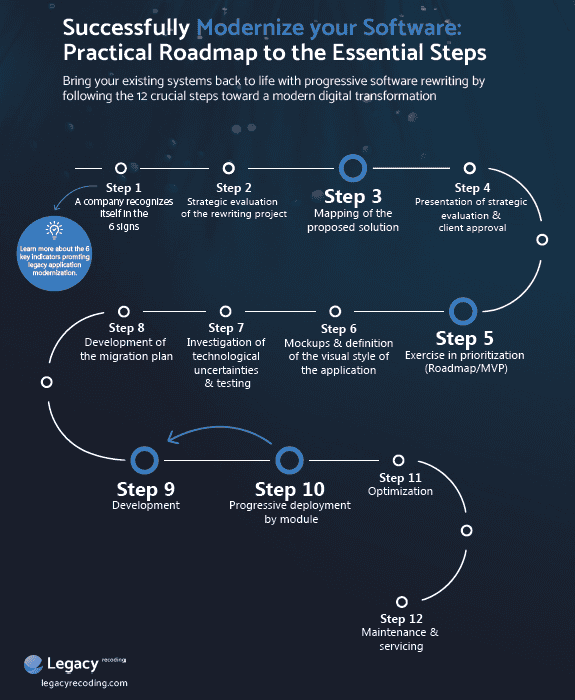Modernization roadmap guide
Download our free checklist and make sure you don’t miss anything during the modernization stages of your application.

In today’s fast-paced technological landscape, businesses often find themselves restricted by outdated software systems that hamper efficiency and growth. While deployment requires a set of best practices in custom development, phased deployment, also known as phased rollout, is a specific and strategic step in the process of modernizing these legacy systems. By implementing new software gradually, companies can minimize risks, manage costs efficiently and ensure a smooth transition.
This method is particularly gaining traction in the manufacturing and distribution industries, where many businesses struggle with antiquated software solutions. Progressive deployment offers a pathway to modernization without the disruptive impact of a complete system overhaul.
Progressive deployment allows businesses to introduce new software systems gradually, in stages, rather than switching over completely in one go, known as the “big bang” approach. This incremental process helps reduce disruptions and allows for continuous monitoring and adjustments.
Key benefits of progressive deployment:
Studies have shown significant productivity gains with progressive deployment. For instance, a report by the Intelligent Transportation Systems Joint Program Office highlights the benefits of phased deployment, noting increased efficiency and reduced downtime in companies that adopted this approach (ITS Knowledge Resources System). Another case from the manufacturing sector saw a 20% increase in operational efficiency when using a phased deployment strategy compared to a non-progressive approach (SpringerLink).

Download our free checklist and make sure you don’t miss anything during the modernization stages of your application.

One of the notable advantages of progressive deployment is its financial flexibility. This method allows businesses to spread out expenses over time, making it more manageable from a financial perspective. Progressive deployment enables organizations to deliver usable components earlier in the process, which can make the project more financially viable and help in meeting specific grant or loan requirements.
Additionally, this approach allows for the phased allocation of project costs, providing the flexibility to halt development if interim results do not meet expectations. This adaptability can be crucial for maintaining financial stability while upgrading systems.
For example, a distribution company that adopted progressive deployment saved 25% on their modernization budget by avoiding the need for a one-time, massive expenditure. These savings were crucial for maintaining financial stability while upgrading their systems (ITS Knowledge Resources System).
Progressive modernization explained
A key advantage of progressive deployment by module in a software modernization project is the ability to manage and reduce risks effectively, similar to constructing a building one floor at a time.
Selecting the right partner for progressive deployment is critical. A software deployment partner is responsible for programming, implementation, and ongoing support. The right partner ensures that the transition is smooth and that all software components are up to date and integrated effectively.
When choosing a partner, it is important to ensure they have extensive experience with progressive deployments. They should ask pertinent questions at the project’s outset about the deployment strategy and how to handle real data from the current system. A good example is a manufacturing firm that partnered with a specialist in ERP systems. This partnership facilitated a seamless transition and faster realization of benefits compared to those who opted for more generalized providers. The right partner can significantly impact the success of the deployment (Codefresh).
Despite its benefits, progressive deployment comes with challenges. Businesses may face issues like integrating new and old systems, ensuring data consistency, and maintaining productivity. However, these challenges can be mitigated with proper strategies.
A crucial aspect of progressive deployment is obtaining continuous feedback from users during each iteration. This allows for quick adjustments and the flexibility to revise the strategy frequently, avoiding bottlenecks caused by a heavy volume of new features. Solutions include using middleware for better communication between systems, comprehensive employee training, and data migration tools to ensure accuracy and consistency. For instance, a company undergoing a progressive software deployment utilized a dedicated data migration tool to maintain data integrity, resulting in a seamless transition (OpenShift).
In summary, progressive deployment offers a balanced approach to modernizing software systems, mitigating risks, managing costs, and maintaining productivity. By understanding its benefits and challenges, and by selecting the right software deployment partner, businesses can ensure a successful modernization process.
As companies navigate the complexities of updating their legacy systems, progressive deployment stands out as an effective strategy. Leaders in manufacturing, distribution, and other industries should consider this approach to achieve maximum success and stay competitive in an increasingly digital world.
Tell us more about your needs so that we can better route your project to our specific SWAT team.
1
During the brainstorming phase, we work with you to identify potential solutions to your business challenges to generate the technology response that aligns with your business objectives.
2
Through our requirements gathering process, we work closely with you to define and prioritize your needs, ensuring that our solutions are tailored to meet your specific requirements.
3
This phase marks the beginning of our partnership. We’ll finalize the project plan and establish clear communication channels to ensure a smooth and successful project execution.